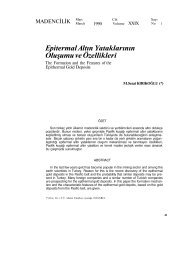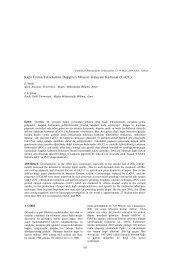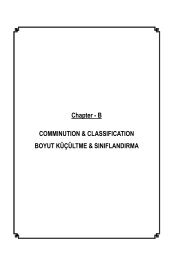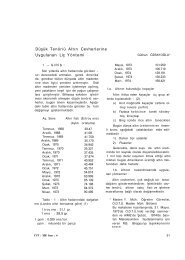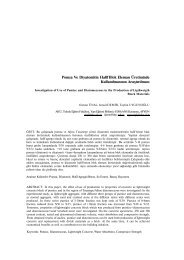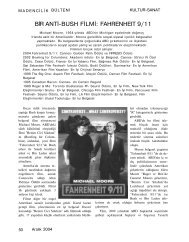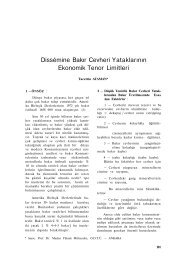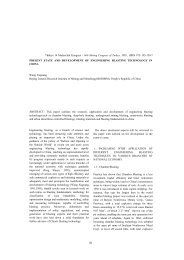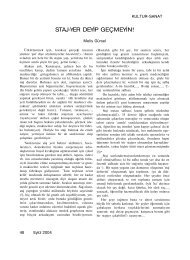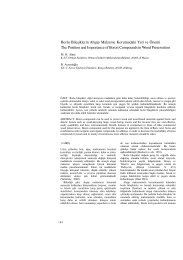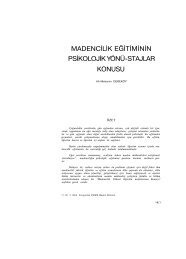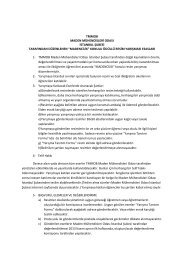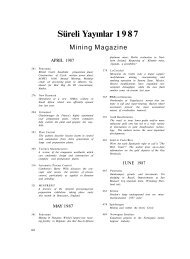A OPEN PIT MINING AÇIK OCAK MADENCİLİĞİ
A OPEN PIT MINING AÇIK OCAK MADENCİLİĞİ
A OPEN PIT MINING AÇIK OCAK MADENCİLİĞİ
Create successful ePaper yourself
Turn your PDF publications into a flip-book with our unique Google optimized e-Paper software.
y alluvium. Green schist and hornfelsic<br />
units are situated in northern part of the<br />
deposit. Granitic units occurred in central<br />
and southern parts of the deposit. Alteration<br />
zones in the deposit consist of silicification<br />
and argilic types. There is silisic veins and<br />
veinlets by aperture between 1 cm and 1 m<br />
and rarely consist of pyrite, chalcopyrite,<br />
malachite and Fe-oxides.<br />
3 IMPLEMENTATION OF REMOTE<br />
SENSING TECHNIQUES FOR DATA<br />
EXTRACTION<br />
3.1 Pre-Processing and Corrections<br />
Before processing the satellite images, it is<br />
necessary that some corrections should be<br />
made on the images, which is called the preprocessing<br />
stage. These corrections are<br />
applied to the raw images, which includes<br />
geometric correction, radiometric correction<br />
(to correct the effects of the uncertainties of<br />
climate, topography and sensitivity of the<br />
sensor) and Layer Stacking (matching VNIR<br />
and SWIR) and etc. In this project, VNIR<br />
and SWIR bands of ASTER image with a<br />
pixel size of 15 m for Layer Stacking (PS =<br />
15m) was made and then a PIX file format<br />
was developed to be used in the processing<br />
stage. Satellite images often contain some<br />
redundant data that calling them "noise" such<br />
as false light and atmospheric effects<br />
(humidity and cloud). The present of this<br />
data, will reduce the image resolution<br />
(contrast).This information should be<br />
removed from image to be clearer.<br />
Therefore, after applying the correction, the<br />
appropriate enhancement and detection is<br />
performed in PCI GeomaticaV9.1 software.<br />
3.2 ASTER Image Processing<br />
Satellite image processing provides the<br />
possibility of extraction geological data:<br />
-Altered distinguish zones according to the<br />
type of geological units.<br />
- Identification and mapping of fractures and<br />
faults to evaluate the structural situation.<br />
-Evaluation of alteration zones associated<br />
with faults and fracture systems<br />
-Separating intrusive units according to their<br />
possible role in mineralization in the area.<br />
3.2.1 Lineaments, faults and structures<br />
extracting<br />
To distinguish structures in satellite<br />
images, usually based on the status of the<br />
plants, the drainages path deviation, an<br />
abrupt change in lithology, differences in<br />
images tone and texture and changing<br />
Lithological unit's trend. Structures are<br />
including major and minor faults, annular<br />
structures that were divided in Image Work<br />
section from PCI GeomaticaV9.1 software<br />
with using different filters in the studied<br />
area. Filter is applied to the better detections<br />
of structures.Geological structures, faults and<br />
ring structures in many geological<br />
environments have significant association<br />
with mineralization. In other word, structures<br />
control the mineralization processes. In fact,<br />
the faults are considered as suitable place for<br />
adoption minerals.<br />
The first Structures that identified by<br />
satellite images were ring Structures. These<br />
structures can be associated with the<br />
intrusive effects which have any outcrops at<br />
the surface, but cause to alterations at<br />
surface. Many alterations occurred at the<br />
intersection of faults or ring structures. Thus,<br />
identifying and mapping on satellite images<br />
help to the exploration of mineral potential<br />
and tectonic position in the study area.<br />
For detection of ring structures in the<br />
study area, ASTER images with different<br />
band combinations were used. Initially, it<br />
was used 1,2,3 band combination in RGB<br />
with using Image Work section from PCI<br />
GeomaticaV9.1 and Arc View 3.2 software<br />
and structures were identified in these band<br />
combination(Fig 3b,3c). Then, 1,3,4 band<br />
combination was used to verify the extracted<br />
data. Concurrent, were used Edge<br />
Sharpening filters (to detect faults border and<br />
ring structures) and Laplacian Edge detector<br />
filter (for separating mountain ridges of<br />
faults).<br />
In Figure 3a, the image of ETM, Landsat 7,<br />
are shown general trend of the overall<br />
structures of study area. As you can see in<br />
180



